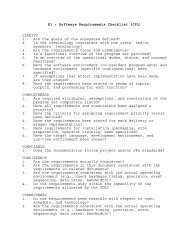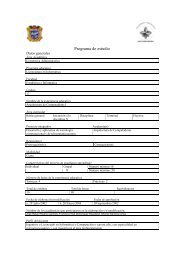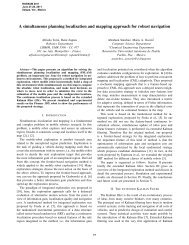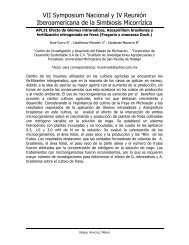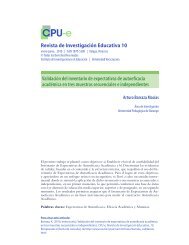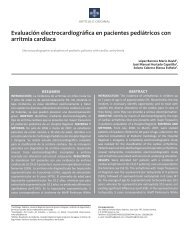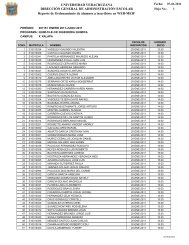Understanding the Software Options
Understanding the Software Options
Understanding the Software Options
You also want an ePaper? Increase the reach of your titles
YUMPU automatically turns print PDFs into web optimized ePapers that Google loves.
Circle 14 on p. 54 or go to adlinks.che.com/35068-14<br />
you get an explanation of <strong>the</strong> benefits<br />
followed by an “it was definitely worth<br />
it” endorsement. These are usually<br />
small projects with a limited scope,<br />
but focused on what makes money.<br />
This is <strong>the</strong> result of <strong>the</strong> different<br />
perspective that <strong>the</strong> Haves and Have<br />
Nots take toward automation:<br />
Haves. The installation of a process<br />
control system, usually a DCS, is not<br />
under discussion — this is just <strong>the</strong><br />
way we do our business. Cost considerations<br />
focus on getting <strong>the</strong> DCS<br />
installed at <strong>the</strong> minimum possible<br />
cost. But this focus on costs can have<br />
an unintended side-effect. Managers<br />
view <strong>the</strong> process control system as a<br />
cost and a sink for money. Managers<br />
do what <strong>the</strong>y are trained to do — manage<br />
<strong>the</strong> cost so as to minimize <strong>the</strong> cost.<br />
Spend more money on a cost? No way!<br />
Have Nots. Not doing <strong>the</strong> automation<br />
project is usually an option. The intense<br />
scrutiny from management can become<br />
burdensome, but <strong>the</strong>re is a beneficial<br />
side effect. The plant manager acquires<br />
a good understanding for what automation<br />
is doing in <strong>the</strong> plant. Automation<br />
is installed only if it is a source<br />
of revenue — <strong>the</strong> benefits exceed <strong>the</strong><br />
costs. And if ano<strong>the</strong>r opportunity arises<br />
to make more money with automa-<br />
tion, <strong>the</strong> plant manager is receptive to<br />
“spending money to make money”.<br />
Recent and future directions —<br />
Hardware<br />
Hardware evolutions largely draw on<br />
advancements from o<strong>the</strong>r segments of<br />
<strong>the</strong> computer industry:<br />
Wireless. By porting <strong>the</strong> wireless<br />
technology developed for routers, cell<br />
phones and so on, into automation<br />
systems, wireless communications<br />
with measurement devices and valves<br />
is now possible. Although being aggressively<br />
promoted, how this technology<br />
will be accepted is difficult to predict.<br />
Electronic devices require power,<br />
which entails ei<strong>the</strong>r batteries or two<br />
strips of copper known as wires. The<br />
wires that power a device can also<br />
be used to communicate with <strong>the</strong> device,<br />
so why go wireless? Wireless will<br />
prove very attractive in certain cases,<br />
but a widespread shift to wireless is<br />
not a sure thing.<br />
Graphics. The 3D graphics technology<br />
from video games and <strong>the</strong> like are sure<br />
to appear in operator interfaces. Is this<br />
really needed in industrial automation?<br />
The answer remains to be seen.<br />
Voice recognition. The capabilities<br />
of modern cell phones are very im-<br />
Since 1968<br />
pressive. Voice recognition is sure to<br />
be ported into industrial automation<br />
systems and has some interesting and<br />
very beneficial possibilities.<br />
Recent and future directions —<br />
Control practices<br />
Being largely home-grown, control<br />
practices within modern control systems<br />
have evolved about as much as<br />
<strong>the</strong> phone component of modern cell<br />
phones.<br />
P&ID. This continues to provide <strong>the</strong><br />
definition for <strong>the</strong> measurement devices,<br />
final control elements, and control<br />
functions for a process. Usually<br />
<strong>the</strong>se rely primarily on single-loop control<br />
structures, in <strong>the</strong> simplified P&ID<br />
in Figure 3 for a chlorine vaporizer. The<br />
organization for <strong>the</strong>se loops is critical.<br />
If this structure accurately reflects<br />
<strong>the</strong> nature of <strong>the</strong> process, <strong>the</strong> controllers<br />
can almost always be successfully<br />
tuned. But if it does not, one or more<br />
controllers prove to be “untunable”.<br />
For something that is so critical, one<br />
would think that <strong>the</strong> rationale for <strong>the</strong><br />
arrangement of <strong>the</strong> loops would be<br />
well-documented. But take one of <strong>the</strong>se<br />
and ask why are we doing it this way?<br />
One answer is that it is done that way<br />
in ano<strong>the</strong>r plant — basically ours is a<br />
CHEMICAL ENGINEERING WWW.CHE.COM AUGUST 2011 35



